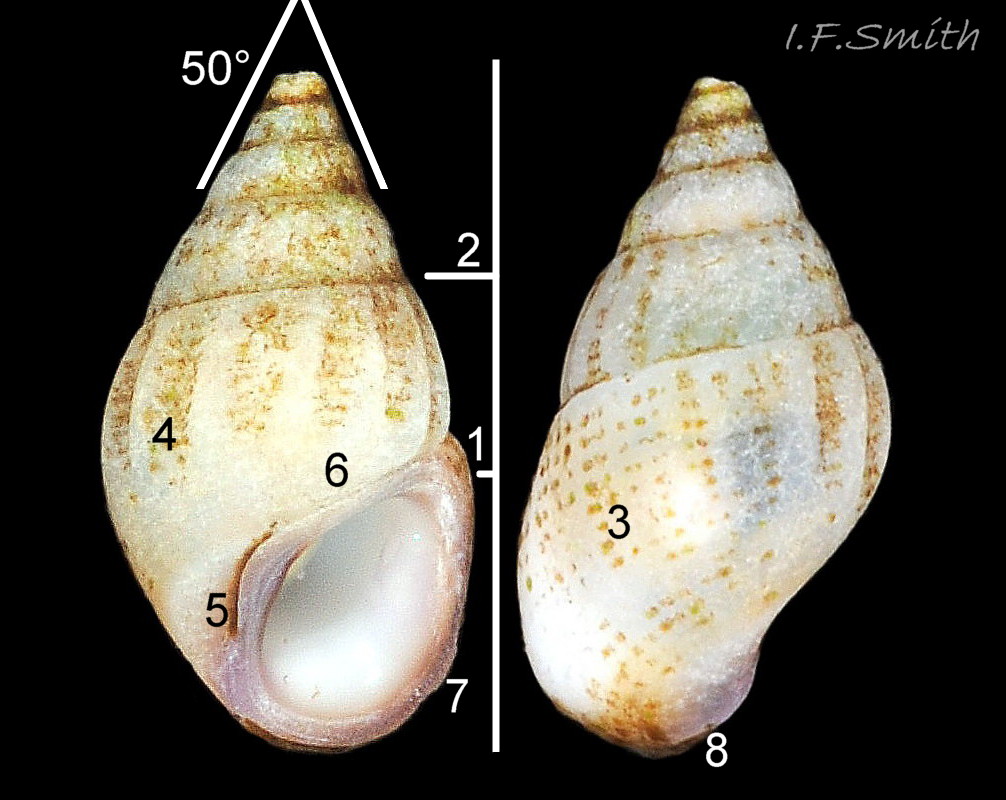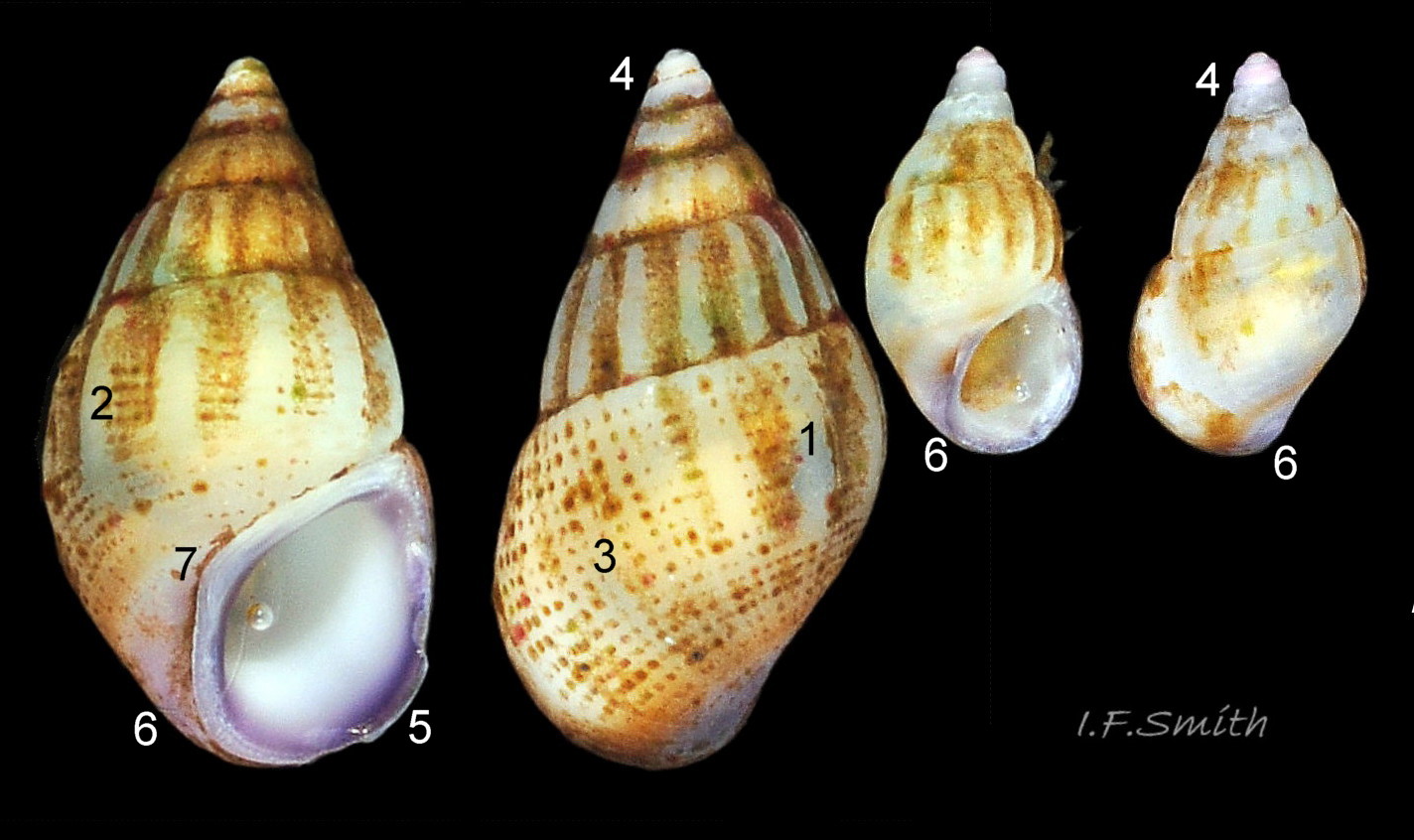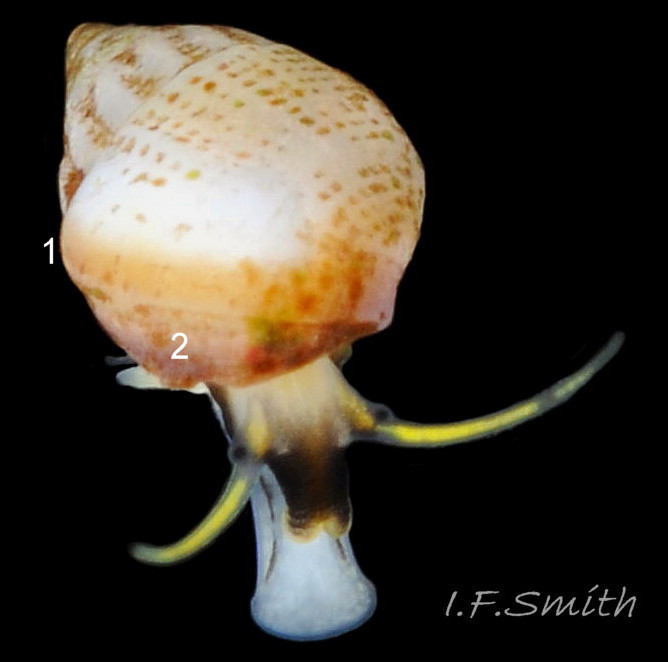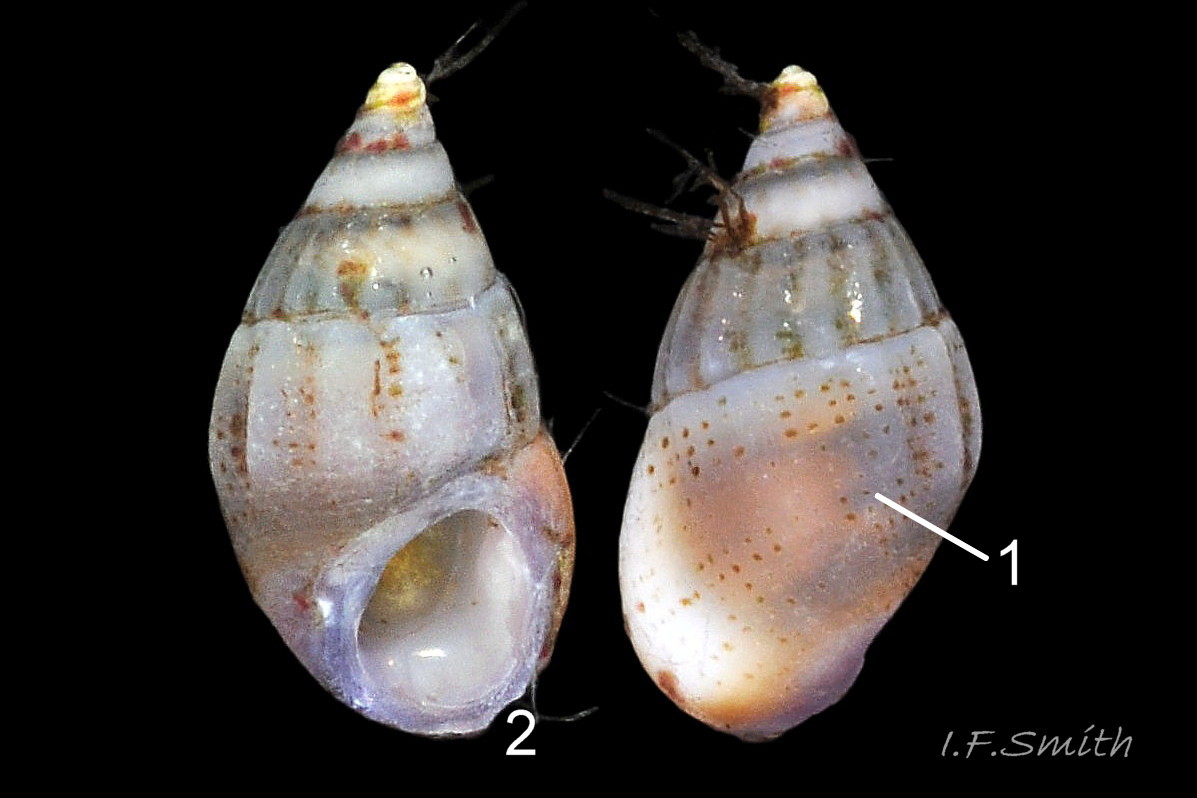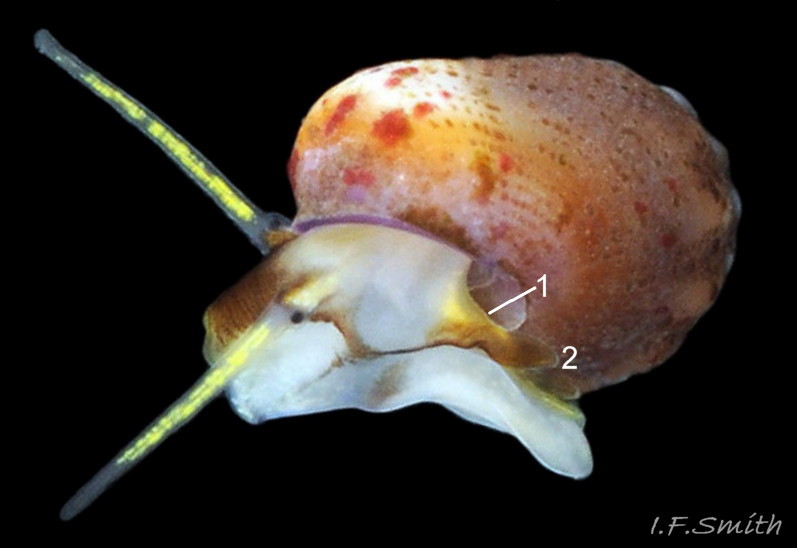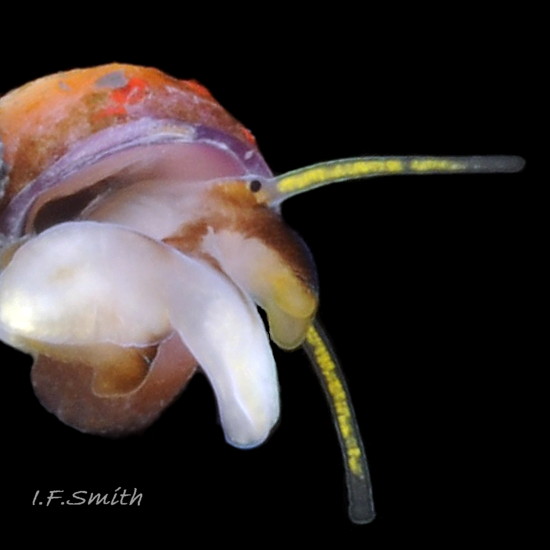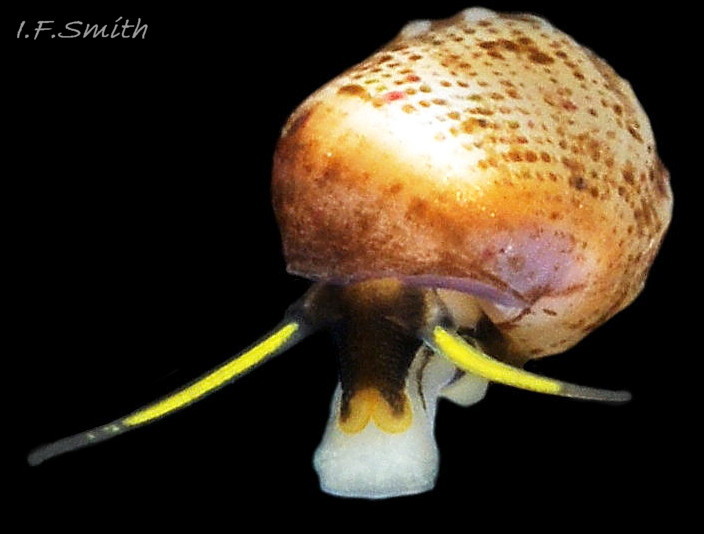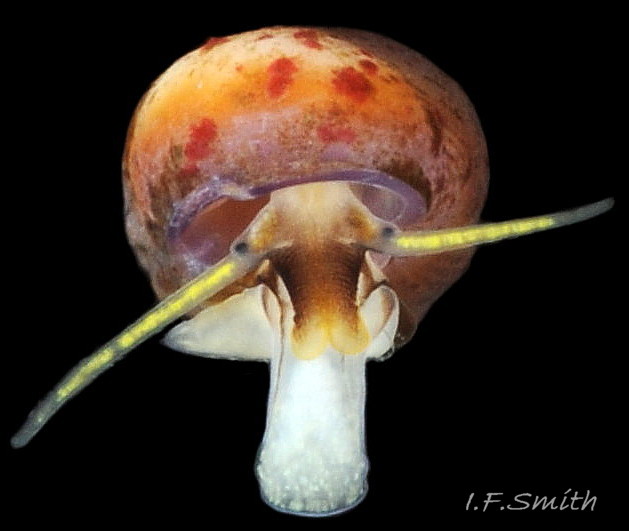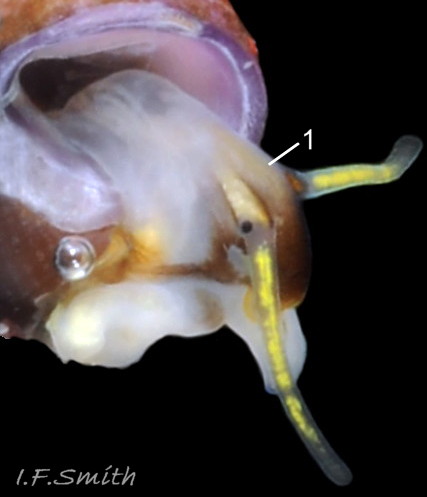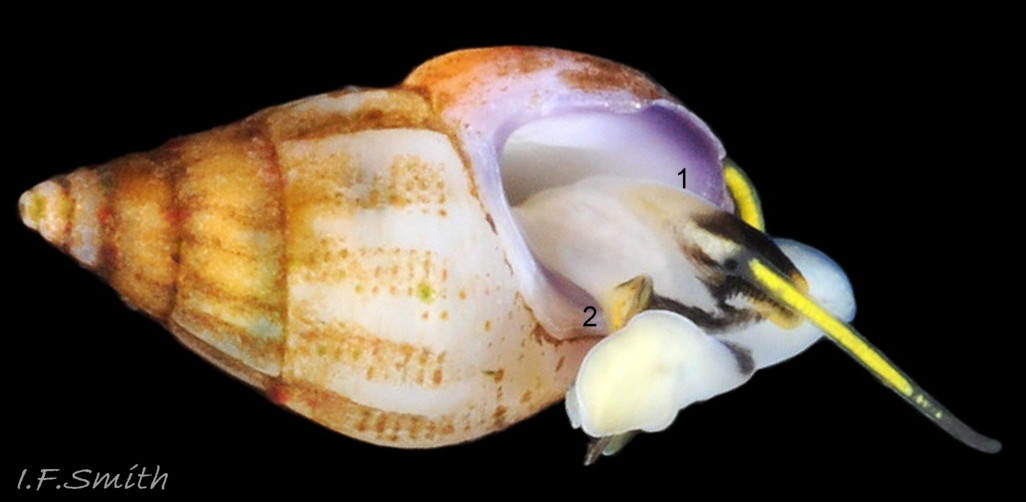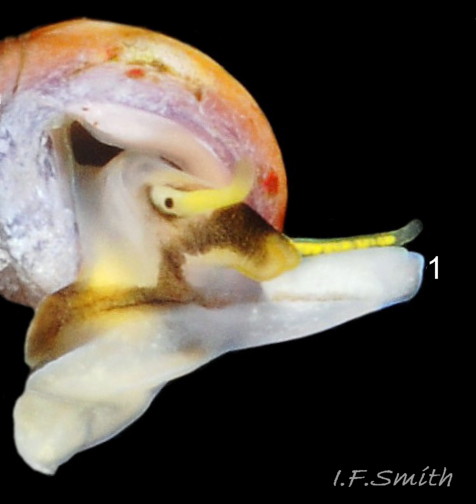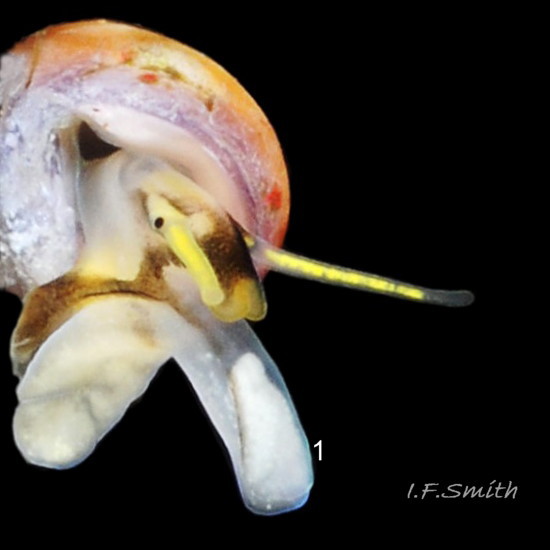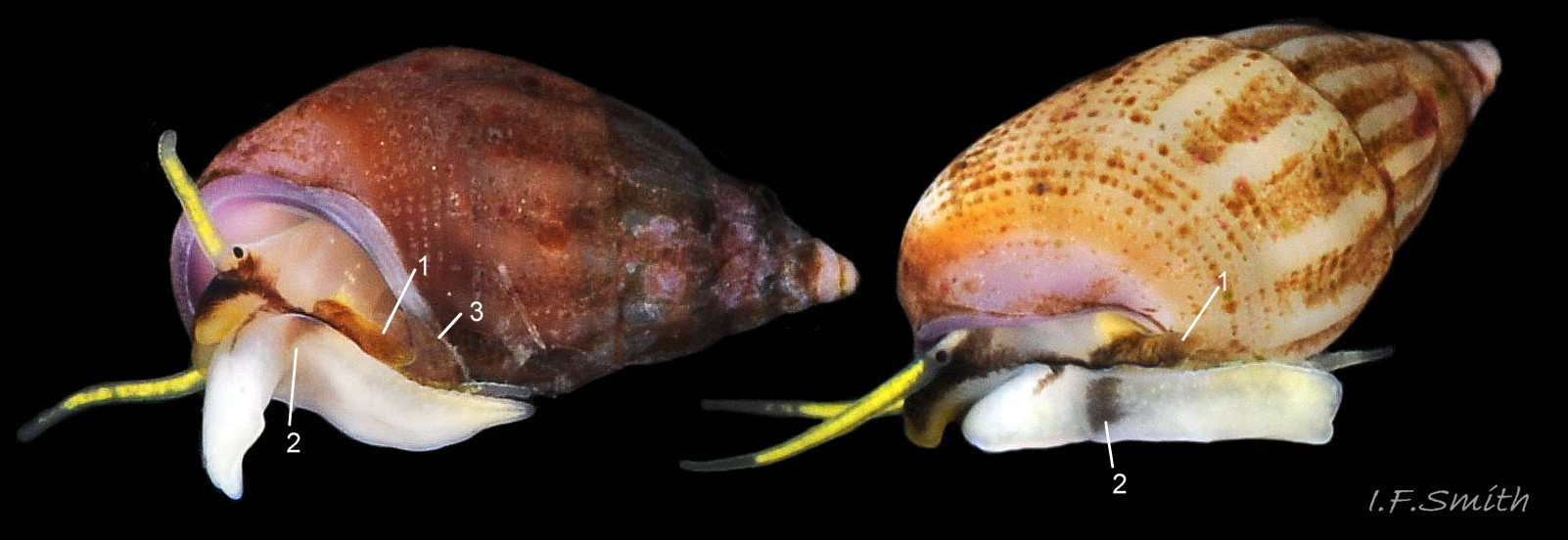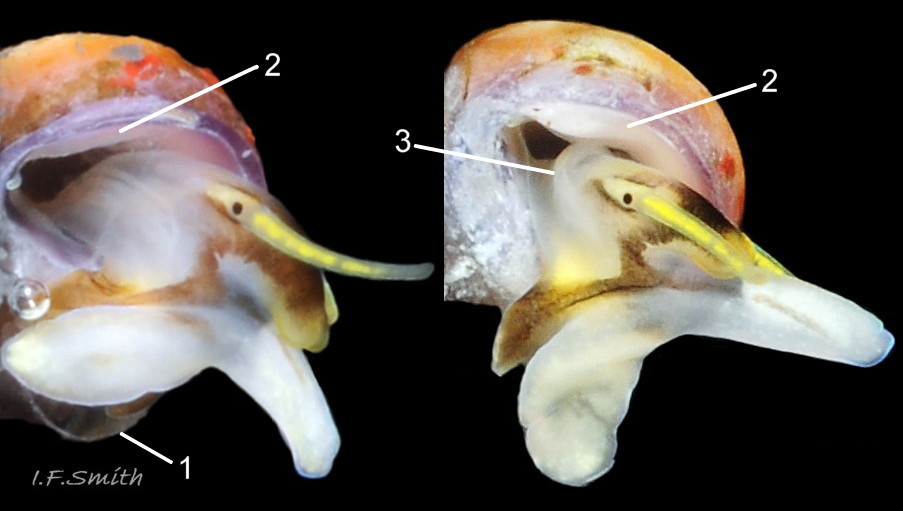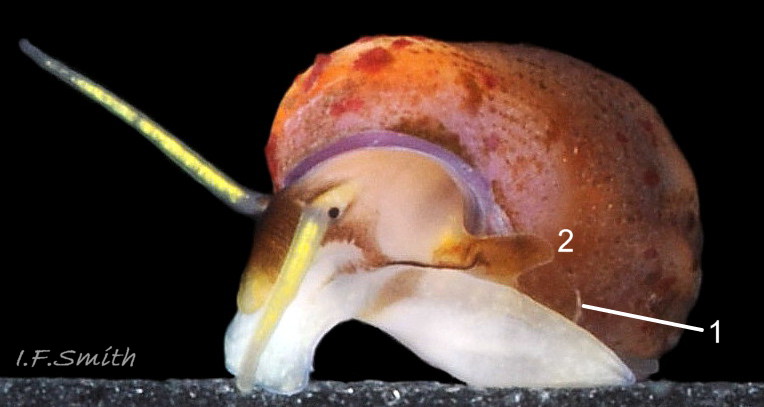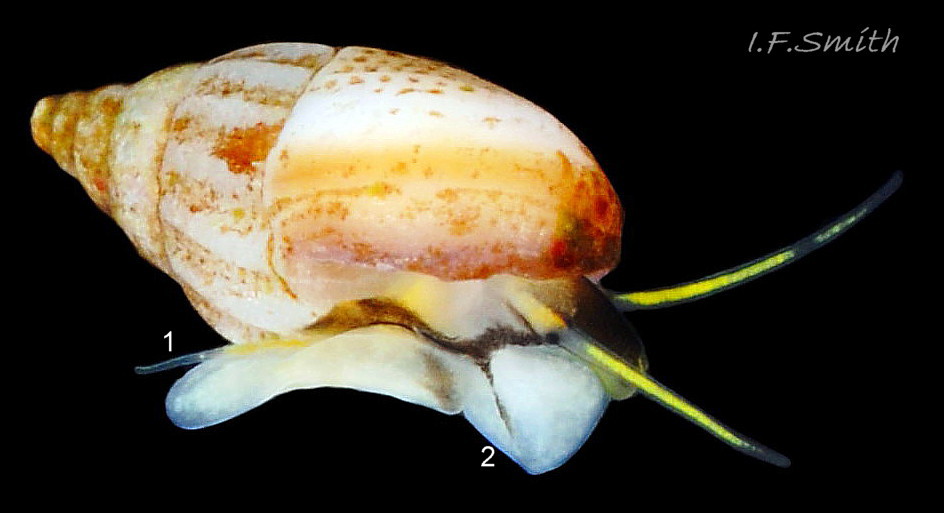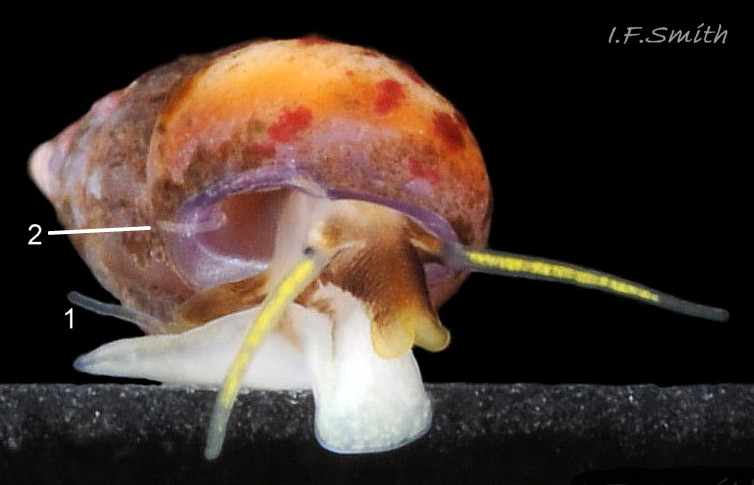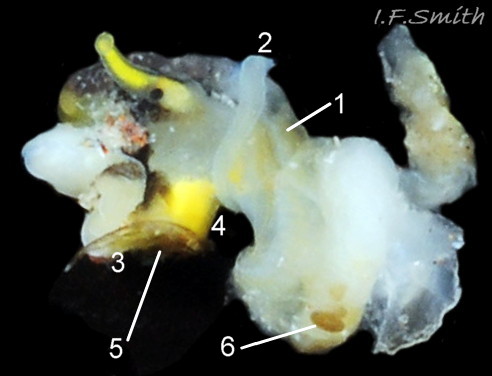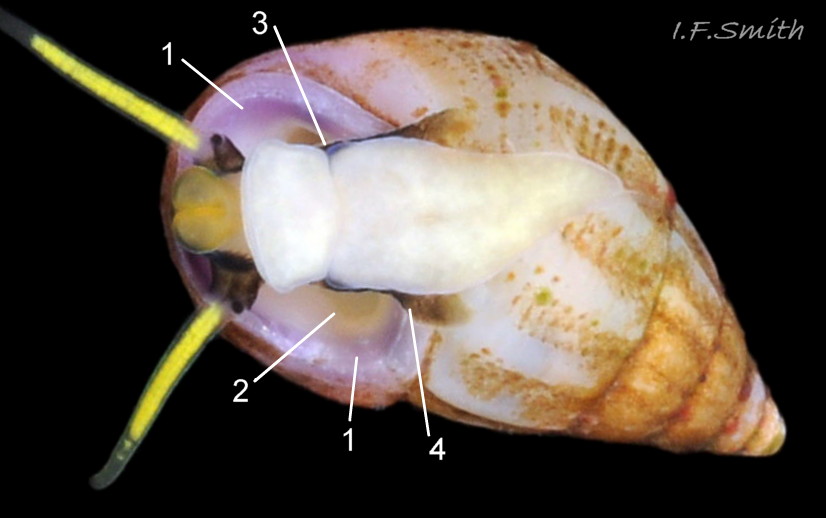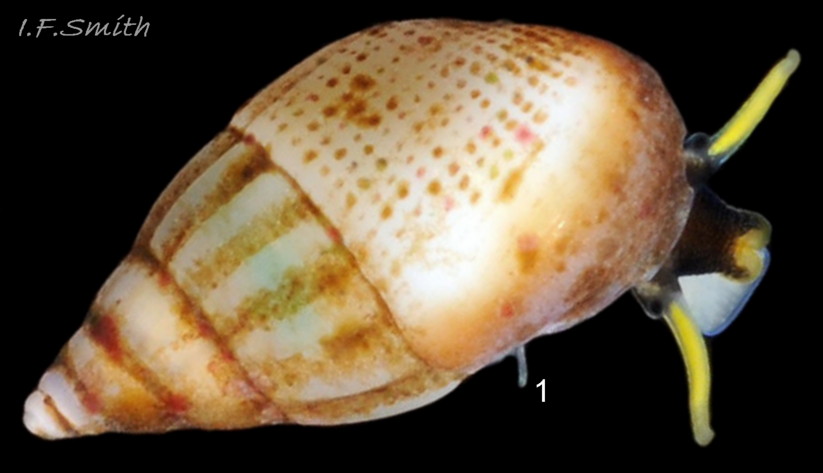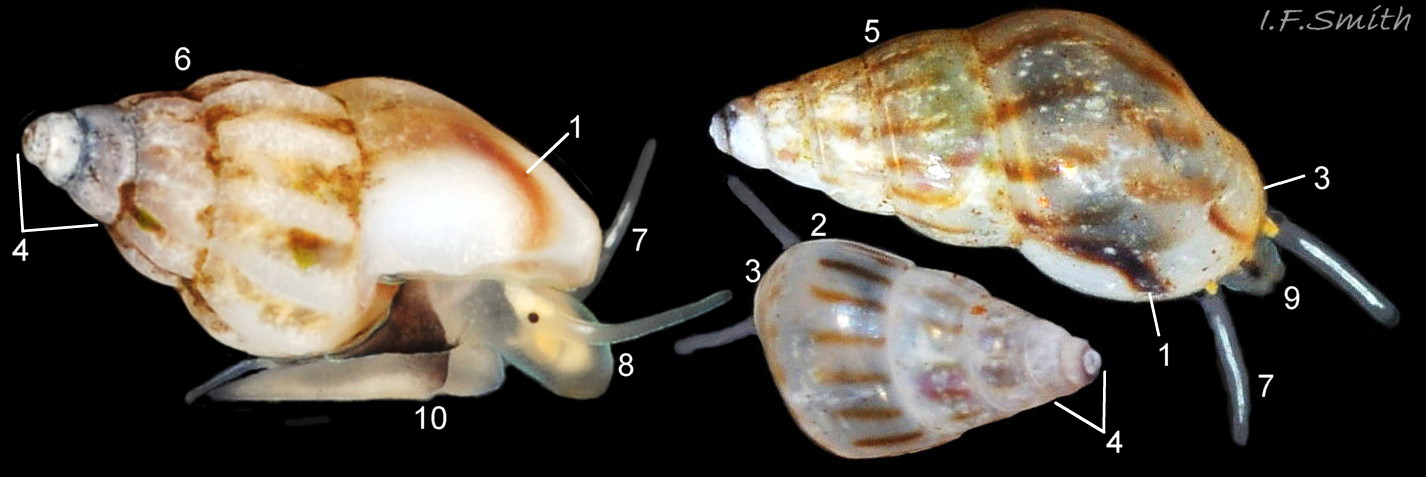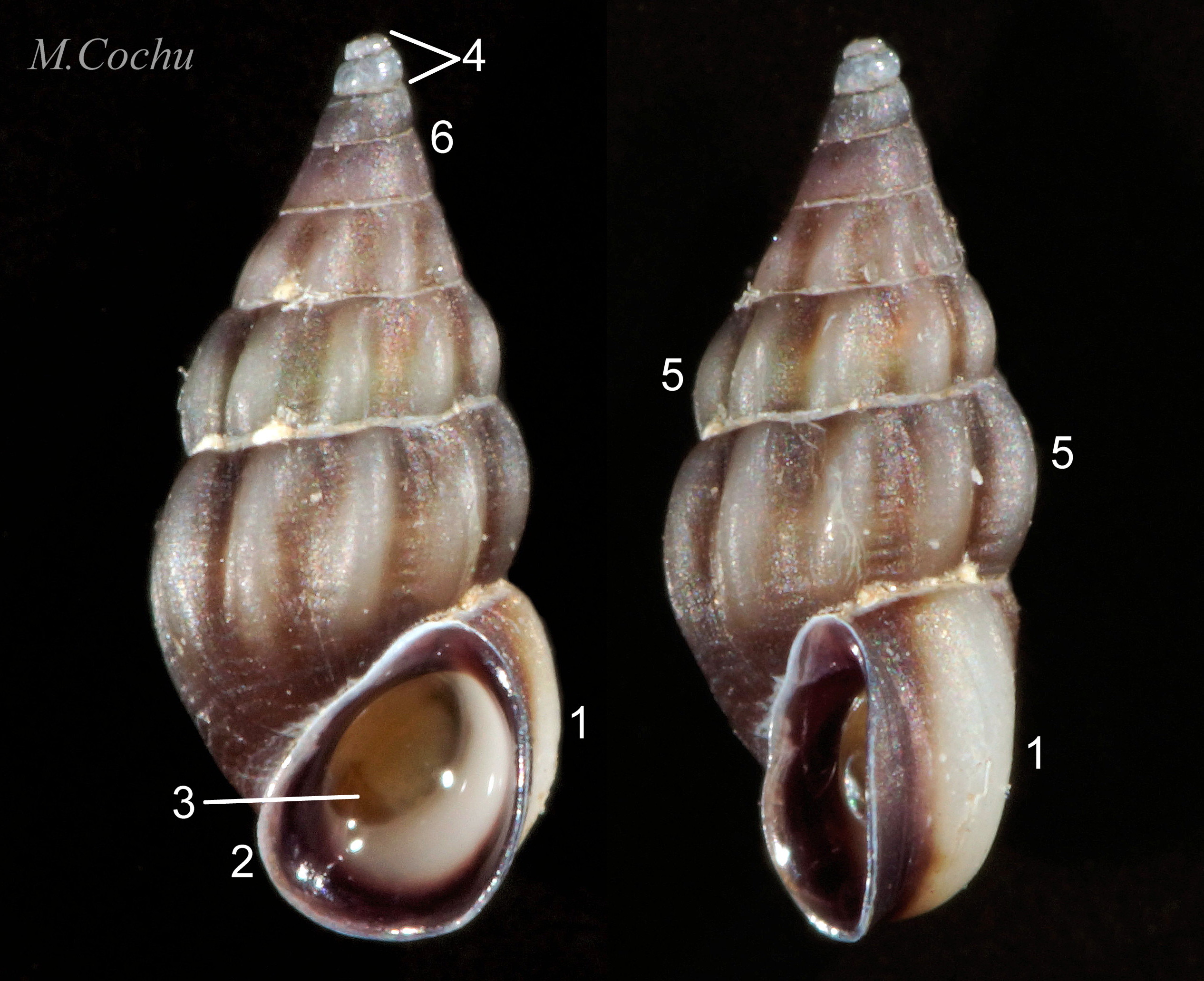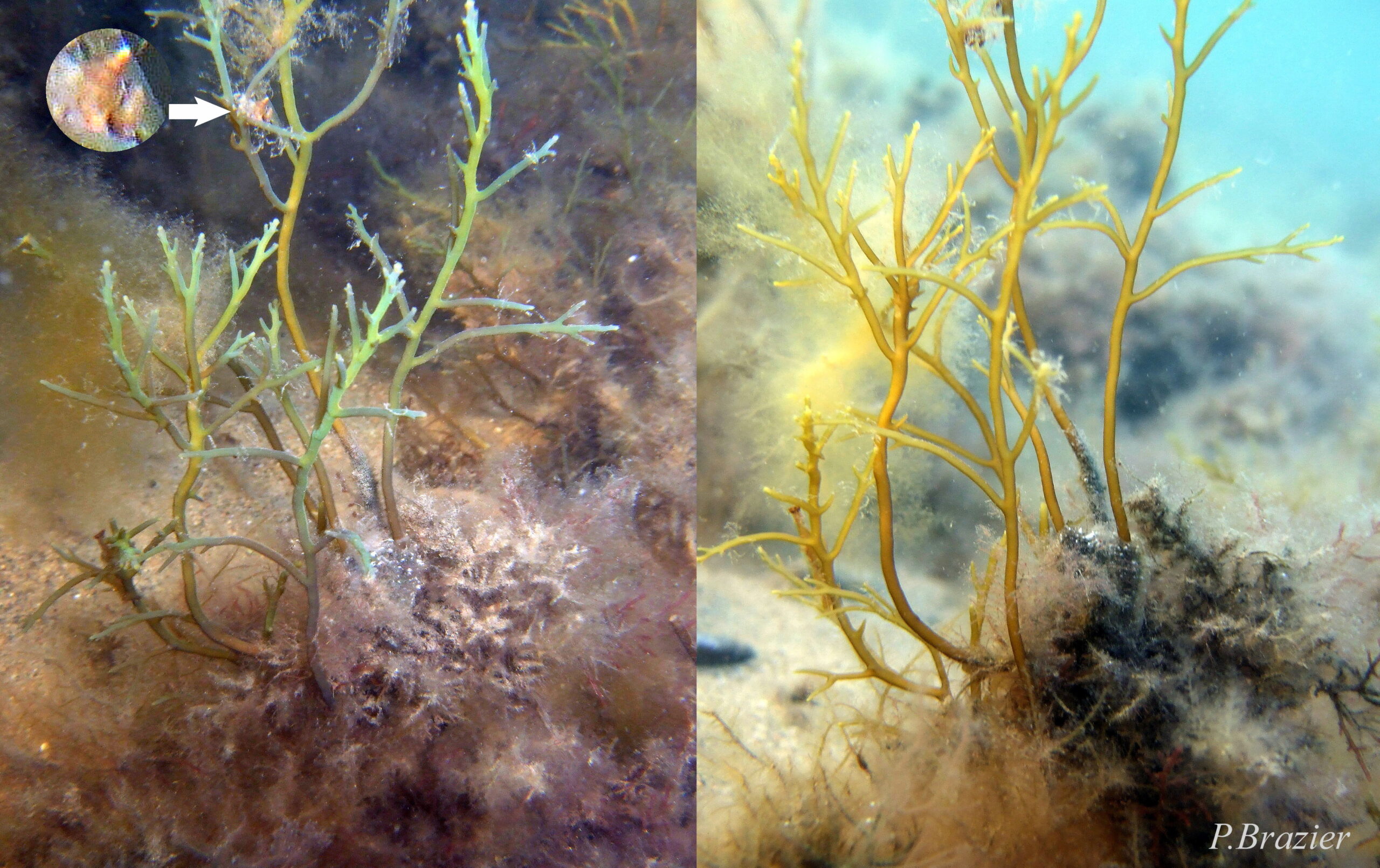Click image to enlarge with full caption. Main text below slider.
Rissoa lilacina Récluz, 1843
Synonyms: Rissoa punctata Potiez & Michaud, 1838; Rissoa rufilabrum Alder, 1844; Rissoa porifera Lovén, 1846; Rissoa violacea var. ecostata Jeffreys, 1867;
Current taxonomy: World Register of Marine Species (WoRMS)
www.marinespecies.org/aphia.php?p=taxdetails&id=141358
Meaning of name: Rissoa = named for G.A. Risso (1777 to 1845).
lilacina = (Latin) lilac (colour of parts of shell).
GLOSSARY below.
Shell description
R. lilacina grows up to 5 mm high and 2.75 mm wide. The spire forms an almost straight sided cone with apical angle c. 50° 01 Rissoa lilacina , except for forms with more tumid whorls and deeper sutures which disrupt the outline and were segregated in Graham (1988) as R. porifera and R. rufilabrum. The body whorl occupies about 65% to 70% of the shell height 01 Rissoa lilacina .
The sculpture varies. Costal ribs can be absent or strongly developed on the largest three whorls of adults 02 Rissoa lilacina . Ribs are more common in the south of Britain including North Wales. In Scotland un-ribbed shells may predominate. Ribs usually cease on the final part of the body whorl so few are visible on its abapertural face but are prominent above the periphery of the apertural face 02 Rissoa lilacina . Except for the ribs, the surface of the shell has about 20 spiral rows of pits aligned to form a rectangular matrix, often made distinct by brown periostracum in the pits surviving the abrasion from the more raised parts.
When fully grown a white labial varix near the outer (palatal) lip 03 Rissoa lilacina , and sometimes a constricting thickening inside the outer lip, develop, but these features may be missing as the peristome is often extensively broken away 04 Rissoa lilacina .
The protoconch consists of an embryonic whorl and a distinct larval whorl. The whorls lack obvious sculpture and are more tumid than teleoconch whorls 05 Rissoa lilacina . The protoconch retains a constant size at all growth stages, so appears relatively larger on small, young shells 02 Rissoa lilacina . If the teleoconch retains much of its brown periostracum, the white protoconch contrasts distinctly with it 06 Rissoa lilacina . The ground colour of the shell is whitish and slightly translucent showing indistinctly the dark animal within 04 Rissoa lilacina . Brown areas and the brown periostracum darken the general appearance of some 06 Rissoa lilacina , but many are lighter because much of the periostracum is eroded, surviving only in the recessed pits and spaces between the costal ribs 01 Rissoa lilacina . The rim of the aperture and sometimes the areas adjacent to it, both in and outside the aperture, are usually stained lilac 02 Rissoa lilacina . The labial varix sometimes has red marks 06 Rissoa lilacina . Dry, vacant, beached shells have usually lost much of their colour 07 Rissoa lilacina .
The aperture height is 35 to 50% of the shell height; its long axis is tilted 30° from the axis of the spire 01 Rissoa lilacina . It has an oval outline that is narrowest adapically and is angled where the short, near-vertical columellar lip joins the parietal lip 02 Rissoa lilacina . When not broken, there is a slight spout at the base of the aperture 01 Rissoa lilacina . There is no open umbilicus but the columellar lip is everted over an umbilical groove. The parietal lip is well formed and, with the columellar lip and thin out-turned palatal lip, forms a distinct continuous peristome when not broken away.
Body description
The flesh is white with brown or black pigment covering the dorsal surface of the snout and extending as a band from below the eye onto and along the foot and onto the widely projecting opercular lobe 08 Rissoa lilacina & 23 Rissoa lilacina . The tip of the snout is deeply bifid and bright yellow 09 Rissoa lilacina & 10 Rissoa lilacina . The contents of the proximal 80% of the slender, tapering, transparent cephalic tentacles are bright canary yellow 10 Rissoa lilacina . The swollen base of each tentacle is coloured brown 14 Rissoa lilacina or black except for an unpigmented section containing a large black eye with an opaque white streak to the posterior of the eye 11 Rissoa lilacina & 12 Rissoa lilacina . The body behind the tentacles is white except for a faint yellowish brown patch between and immediately behind the tentacles 12 Rissoa lilacina & 13 Rissoa lilacina .
When fully extended, the foot is widest and truncated at the anterior and tapers to a rounded posterior point 14 Rissoa lilacina . Its bilaminate, anterior edge 15 Rissoa lilacina contains the outlet for mucus from the large, opaque white, triangular, anterior pedal mucous gland 16 Rissoa lilacina . The gland is edged on the dorsal surface of the foot with a thin greyish or brownish line along each side. There is a strong groove across the foot and constriction at 25% of its length from the anterior 14 Rissoa lilacina & 23 Rissoa lilacina . There is a, sometimes faint, brown or black mark down the flanks of the foot along the posterior of the groove 17 Rissoa lilacina . The posterior half of the sole has an opening to the posterior pedal gland 14 Rissoa lilacina .
The operculum is transparent tinted brownish 14 Rissoa lilacina & 18 Rissoa lilacina and often difficult to discern 14 Rissoa lilacina . It rests on a brown or black opercular disc which protrudes laterally as prominent opercular lobes 19 Rissoa lilacina . Part of the disc is yellow where it consists of the end of a yellow columellar muscle attached to the operculum 08 Rissoa lilacina & 13 Rissoa lilacina . A long metapodial tentacle which is proximally yellow and distally translucent whitish 20 Rissoa lilacina & 21 Rissoa lilacina extends from the yellow part of the opercular disc to or beyond the posterior tip of the foot when in motion.
The mantle is translucent white 22 Rissoa lilacina showing the colours of the shell interior through it 23 Rissoa lilacina with a short, translucent pallial tentacle protruding beyond the shell 24 Rissoa lilacina from the adapical angle of the aperture 21 Rissoa lilacina . Within the mantle cavity a substantial white ctenidium stretches from left to right under the roof and males have a penis attached to the body behind the cephalic tentacles 18 Rissoa lilacina .
Key identification features
Rissoa lilacina
1) Maximum height 5 mm.
2) Costal ribs can be absent or strongly developed on the largest three whorls of adults 06 Rissoa lilacina .
3) White labial varix, when fully grown, may have a few red brown marks, but not a brown falciform mark (comma) across it 06 Rissoa lilacina .
4) Aperture rim and sometimes adjacent areas inside and outside the aperture are usually stained lilac.
5) Protoconch has two tumid, white whorls, occasionally tinted lilac 05 Rissoa lilacina . Teleoconch whorls only slightly tumid.
6) Translucent white cephalic tentacles have a thick, medial, bright canary yellow line within them 17 Rissoa lilacina .
7) Brown or black pigment covers dorsal surface of snout and extends as a band onto and along foot and to widely projecting opercular lobe 17 Rissoa lilacina .
8) Brown or black mark down the flanks of the foot, often faint and does not spread far onto sole 17 Rissoa lilacina .
9) Mediterranean to Norway, excluding inner Baltic and much of the North Sea.
Similar species
Rissoa parva (da Costa, 1778) 25 Rissoa lilacina COMPARE Rissoa parva
1) Maximum height 5 mm.
2) Costal ribs can be absent or strongly developed.
3) When fully grown, usually has a white labial varix with a brown falciform mark across it.
4) Aperture rim not usually stained lilac.
5) Protoconch has 3 or 4 white whorls when unworn, occasionally tinted lilac. Teleoconch whorls vary from slightly tumid to distinctly tumid.
6) Translucent white cephalic tentacles have a thin, sometimes discontinuous, medial, opaque white line within them.
7) Snout translucent whitish; sometimes has narrow blackish mark and/or a few opaque white marks.
8) Broad transverse dark band on foot spreads onto periphery of sole.
9) Northern Norway to Canary Islands, Mediterranean and Black Sea. Not inner Baltic.
Rissoa guerinii Récluz, 1843 26 Rissoa lilacina COMPARE Rissoa guerini
1) Maximum height 6 mm.
2) Costal ribs well developed.
3) When fully grown, has a thick, white labial varix.
4) Aperture rim not usually stained lilac. Patch of lilac-brown often in throat of aperture.
5) Protoconch has two tumid, often whitish-grey whorls. Teleoconch whorls distinctly tumid, except two uppermost.
6) Translucent white cephalic tentacles have within them a sometimes fragmentary, opaque, yellow line.
7&8) Snout and sides of foot brown (Graham, 1988)
9) Canary Islands and Mediterranean northwards to Bretagne and south-west England.
Habits and ecology
R. lilacina lives at LWST and sublittorally to 20 m at salinities above 21‰ (Warén, 1996). It is found on some Zostera beds and on algae, such as Treptacantha nodicaulis (Withering) Orellana & Sansón, attached to stones on sandy substrate in sheltered sites such as coastal lagoons 27 Rissoa lilacina . It feeds on diatoms, organic detritus and fragments of algae swept with its radula from the surface of the Zostera or algae. Frequent damage to the lip and body whorl of the shell in sheltered conditions is probably the result of attack by crabs 04 Rissoa lilacina .
Locomotion: The anterior pedal mucous gland 16 Rissoa lilacina discharges within the bilaminate anterior edge of sole 15 Rissoa lilacina , which spreads the mucus to lubricate creeping. The posterior pedal gland 14 Rissoa lilacina secretes mucus which hardens on contact with sea water to form strong threads to anchor the snail and act as climbing lines in its movement around algae. Turning and folding 16 Rissoa lilacina are assisted by the transverse crease across the foot 14 Rissoa lilacina . R. lilacinafeeds by grazing algal fragments, detritus and microphytes with its radula from the surface of algae. It produces orange-brown, oval faecal pellets 22 Rissoa lilacina .Little is known of its reproduction. Males are smaller than females and have a penis for internal fertilization. Captive spawning starts at 8 to 9°C and increases at 10 to 11°C (Warén, 1996). The egg capsules are shaped as a hemispherical lens with a narrow marginal brim (Fretter & Graham, 1978), diameter 1.3 to 1.5 mm containing 60 to 80 ova (Warén, 1996). They are probably attached to alga and/or the shells of other individuals. No data are available on larval development but the different embryonic and larval whorls of the protoconch 05 Rissoa lilacina suggest that there is a free living planktonic veliger stage similar to that of other rissoids.
Distribution and status
Rissoa lilacina occurs from Lofoten, Norway to the Mediterranean but is absent from the inner Baltic and most of the North Sea. It was especially abundant on Zostera in the Kattegat before destruction of the plant by disease in the 1930s (Warén, 1996). It is locally abundant in suitable habitats but occurs at far fewer sites in Britain than Rissoa parva and Pusillina inconspicua, which are usually found with it. GBIF map www.gbif.org/species/8205460 . It is found at suitable sites in Ireland, except on some of its Irish Sea coast, and in Britain except the coasts of the North Sea and north-east Irish Sea, U.K. map NBN species.nbnatlas.org/species/NHMSYS0021055540
Acknowledgements
I gratefully thank Paul Brazier and Florence and Marc Cochu for use of images.
Links and references
Alder, J. 1844. Descriptions of some new British species of Rissoa and Odostomia. Ann. Mag. nat. Hist.13 (series 1): 323-328 & plate viii preceding p. 323 . (as Rissoa rufilabrum.) archive.org/details/annalsmagazineof13lond/page/325/mode/1up
Cochu, F. & Cochu, M. Rissoa guerinii, Nature 22, Estran 22, faune et flore de la zone de balancement des marées en Côtes d’Armor. (accessed February 2023). nature22.com/estran22/mollusques/gasteropodes/gasteropode…
Forbes, E. & Hanley S. 1849-53. A history of the British mollusca and their shells. vol. 3 (1853), London, van Voorst. (as R. rufilabrum) p. 106 & plate xxvii archive.org/details/historyofbritish03forbe/page/106/mode…
Fretter, V. and Graham, A. 1962. British prosobranch molluscs. London, Ray Society.
Fretter, V. and Graham, A. 1978. The prosobranch molluscs of Britain and Denmark. Part 4– Marine Rissoacea. J. Moll. Stud. Suppl. 6, 153-241.
Graham, A. 1988. Molluscs: prosobranch and pyramidellid gastropods. Synopses of the British Fauna (New Series) no.2 (Second edition). Leiden, E.J. Brill/Dr. W. Backhuys. 662 pages.
Høisaeter, T. 2009. Distribution of marine, benthic, shell bearing gastropods along the Norwegian coast. Fauna Norvegica 28: 5-106 www.researchgate.net/publication/41758474_Distribution_of…
Jeffreys, J.G. 1862-69. British conchology. vol. 4 (1867). London, van Voorst. archive.org/details/britishconcholog04jeffr/page/32/mode/… . p.33. (as R. violacea)
Rasmussen, E. 1973. Systematics and ecology of the Isefjord marine fauna (Denmark). Ophelia, 11, 1-495.
Warén, A. 1996. Ecology and systematics of the north European species of Rissoa and Pusillina (Prosobranchia: Rissoidae). J. mar. biol. Ass. U.K. 76, 1013-1059.
Wigham, G.D. & Graham, A. 2018. Marine gastropods 3: Neogastropoda. Synopses of the British Fauna (New Series) no.62. (206 pages). Field Studies Council,Telford, England.
Glossary
adapical = towards the apex of the shell.
aperture = mouth of gastropod shell; outlet for head and foot.
bifid = divided into two parts by a cleft.
bilaminate = (adj.) formed of two layers.
cephalic = (adj.) of or on the head.
coll. = in the collection of (named person or institution, compare with legit).
columella = solid or hollow axial “little column” around which gastropod shell spirals; hidden inside shell, except on final whorl next to lower part of inner lip of aperture where hollow ones may end in an umbilicus or siphonal canal.
columellar = (adj.) of or near central axis of spiral gastropod.
columellar lip = lower (abapical) part of inner lip of aperture.
costa = strong rib running across a whorl of a gastropod shell at right angles to direction of coiling and any spiral striae.
costae = (pl.) strong axial ribs running across a whorl of a gastropod shell at approximately right-angles to direction of coiling and any spiral striae.
costal = (adj.) of, or arranged like, costae.
costate = bearing costae.
diatom = microscopic aquatic alga with siliceous cell-walls.
ctenidium = comb-like molluscan gill; usually an axis with a row of filaments either side.
ELWS = extreme low water spring tide (usually near March and September equinoxes).
embryonic whorl = tiny, initial, apical whorl of gastropod; formed while embryo in ovum. It plus larval whorls comprise the protoconch. [Some sources confusingly call whole protoconch the embryonic whorls.]
falciform = shaped like a sickle blade.
height = (of gastropod shells) distance from apex of spire to base of aperture.
labial varix = especially strong or broad costa (rib) along edge of outer lip of aperture. Sometimes other varices mark positions of previous prolonged pauses in growth.
larval whorls = whorls near apex of gastropod shell formed while a planktonic veliger larva. They plus initial apical embryonic whorl comprise the protoconch.
legit = (abbreviation; leg.) collected/ found by (compare with coll.)
mantle = sheet of tissue that secretes the shell and forms a cavity for the gill in most marine molluscs.
LWST = low water spring tide, two periods of a few days each month when tide lowest.
metapodium = hind part of the foot.
metapodial = of the metapodium.
mucus = (noun) viscous, slippery substance secreted by various glands on molluscs.
mucous = (adj.) pertaining to mucus.
opercular = (adj.) of the operculum.
opercular disc = part of foot that growing operculum rotates on.
opercular lobe = extension of opercular disc beyond edge of operculum.
operculum = plate of horny conchiolin, rarely calcareous, used to close shell aperture.
palatal lip = outer lip of gastropod aperture.
peristome = entire rim of aperture.
plankton = animals and plants that drift in pelagic zone (main body of water).
protoconch = apical whorls produced during embryonic and larval stages of gastropod; often different in form from other whorls (teleoconch).
stria = (pl. striae) very narrow spiral groove.
suture = groove or line where whorls of gastropod shell adjoin.
teleoconch = part of shell other than the apical protoconch.
umbilicus = cavity up axis of some gastropods, open as a hole or chink on base of shell, often sealed over.
veliger = shelled larva of marine gastropod or bivalve mollusc which swims by beating cilia of a velum (bilobed flap).
